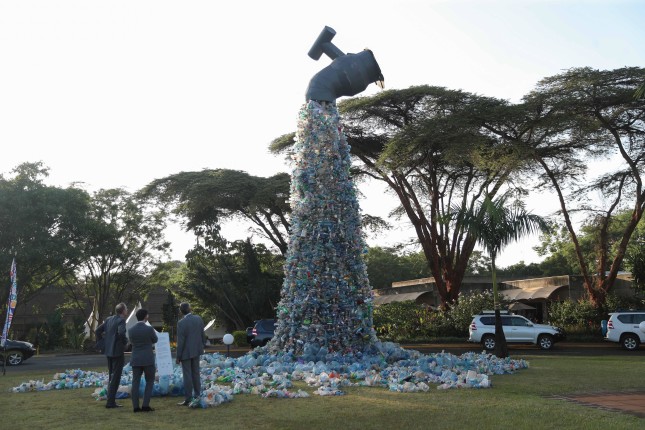-
World’s Nations Commit to Ending Plastic Waste
March 15, 2022 By Emma BryceThe United Nations has laid the foundation for negotiations to begin on the world’s first legally binding treaty to end plastic pollution. At the United Nations Environment Assembly (UNEA) in Nairobi earlier this month, the parameters were set for a future treaty, including hard-won provisions to address the full life cycle of plastics and tackle waste in all environments, not just the ocean.
The decision on 2 March was met with applause, cheers, and tears from delegates of 175 member states. They had gathered to negotiate several multilateral environmental agreements, but most notably one on plastics.
“The bottom line is, we will eliminate plastic pollution from our environment,” said Inger Andersen, executive director of the United Nations Environment Programme (UNEP), during the closing plenary.
“It’s a really important step. When I first started working on [plastics], there wasn’t a broad consensus about the scale of the problem, or even agreement that there was a problem,” explained Richard Thompson, a marine scientist at the University of Plymouth who has been studying plastic pollution for 30 years, and coined the term microplastics, in an interview.
With plastic production doubling from 234 to 460 million tonnes in the past 20 years, it is now accepted that the scale of the resulting pollution means that neither voluntary nor national actions are enough. In recent years there has been a push for a coordinated global response, backed by a Scientists’ Declaration and popular opinion. A survey published last month by WWF revealed that nine out of 10 citizens in 28 countries believe in the need for a global treaty on plastic waste, with the greatest support coming from Mexico, Peru, and China. Even plastics producers and brands heavily dependent on plastic packaging, such as Coca-Cola, Nestlé, and Unilever, are backing the idea.
This mounting support came to a head during a week of negotiations in late February, when countries used two proposals for tackling plastic pollution put forward by Rwanda and Peru and by Japan as the basis for a final resolution. After days of heated discussion and fine-tuning, a draft was tabled for consideration by the world’s environment ministers in the early hours of 28 February, the day the UNEA began.
Ambitious, urgent and wide-ranging
The adopted text has been called the “most important” deal since Paris and mandates that a final treaty be legally binding, which was not a guarantee at the start of negotiations. The text, which calls for an “end”, rather than a reduction, to plastic pollution, sets an ambitious 2024 deadline for finalizing the treaty.
In an interview, Christina Dixon, deputy campaign lead for oceans at the NGO the Environmental Investigation Agency (EIA) and was an observer during the negotiations, commented that “countries have come together and said, ‘We want to do this quickly in recognition of the urgency of the problems.’”
Civil society groups are celebrating the ambitious scope of the resolution, which reduces the risk of negotiators delivering a narrow and toothless treaty. The text asserts that negotiations must focus on ending all plastic pollution in all ecosystems, not just marine environments (where most policy efforts are currently focussed due to the large-scale impacts there). This provision is important given river-transported plastic is a major source of ocean pollution, particularly in Asia.
The resolution also uses a generous interpretation of “impact.” Rather than just plastic waste, it considers the well-established risks that chemicals from plastics pose to human health, with microplastics now found in major organs including human placentas.
Crucially, it specifies that a future treaty must address the full life cycle of plastic if it is to succeed. This widens the scope beyond tackling waste management to potentially reduce production, especially of single-use products.
“The industry is always saying, ‘We need a better mop.’ But in reality, we need to turn off the tap,” comments Christopher Chin in an interview. Chin, an expert on single-use plastic legislation and executive director of the nonprofit Center of Oceanic Awareness, Research, and Education, and an observer at the talks, added that the resolution responds to that need by “looking at plastic pollution in a more holistic way.”
The resolution includes provisions for financing, Dixon noted, which will help countries meet their legal obligations once a treaty comes into force. That’s important because, as the text highlights, establishing new circular economies will be key to limiting plastic production, increasing recycling, and extending its life. Such circular economy upgrades will require significant resources in countries that don’t have the capacity yet.
The resolution calls for national action plans and better plastic production and waste monitoring, crucial to measure progress. It also highlights the role of indigenous and traditional knowledge in forming solutions, and recognizes the role of informal waste pickers in recycling plastic globally.
“Broadly speaking, we’re pretty happy with the contents of the resolution,” said Dixon. “There’s a reference to health, which means that we can have a conversation about [toxins from plastics],” she added. “It talks about sustainable production and consumption, which means we can talk about reporting on plastic production.” Now, she cautioned, “is when the hard work begins.”
From resolution to treaty
The resolution establishes an intergovernmental negotiating committee, which will thrash out the terms of the final treaty. Its first meeting is scheduled for May 2022 in Senegal.
Some of the tougher debates will center around how the treaty enables all countries to enact the necessary changes to their plastic economy—such as establishing circular infrastructure. Colombian lawyer Mónica de Greiff Lindo, speaking at the UNEA on behalf of the G77 and China, emphasized that developing countries will need finance and technology transfer from developed countries to transition to sustainable systems of consumption and production. Firming up countries’ obligations for this will be crucial, she said.
Another challenge is creating supportive markets for plastic alternatives and recycled materials. “We see the treaty as an enabler of progress,” remarked Ed Shepherd, senior global sustainability manager at the consumer goods giant, Unilever, speaking at a UNEA side event. But he added that the low price of virgin plastics may discourage businesses from getting their new products ready for the circular economy. One way for the treaty to correct skewed market dynamics would be to introduce extended producer responsibility schemes that create laws requiring companies to take responsibility for managing their plastic packaging from cradle to grave. Such schemes also can build the costs of plastic waste into production, or apply a tax on virgin plastics.
Christopher Chin cautioned that open-ended wording in the resolution text around the “full life cycle” of plastics could lead to questions about where exactly a plastic’s “life” begins, and therefore who has responsibility to tackle production and waste. “Some people will tell you that the lifecycle of plastic begins as a product, or as a polymer, or at extraction,” he explains. On this point, Dixon pointed out that the EIA will be watching for lobbying during the negotiations, because the new life cycle focus might bring fossil fuel companies into the picture: “The petrochemical industry hasn’t really had to worry about this until the deal was done,” she concluded.
Search for solutions
Richard Thompson says that in the inevitable scramble for solutions that this global agreement will trigger, more research is needed to determine what really works. “We’ve got more evidence than we need about [plastics’] harm. What we don’t have as much evidence about is how to apply which solution in which context, in order to get the best traction,” he says.
This will require environmental scientists, economists, materials scientists, behavioral psychologists, and others to come together to find holistic solutions along the entire plastics life cycle, he says. Without this, a treaty runs the risk of enforcing measures that are ill-fitted to the challenge.
In the meantime, during the closing plenary the UNEP executive director Inger Andersen urged countries to take the momentum of the talks back home. She used Kenya, the home of the UNEA, as an example of a country that has recently brought in decisive bans on single-use plastics. “Do not sit back and wait for the plastic treaty to be ratified and signed,” she said. “There is lots that you can do.”
Emma Bryce is a freelance journalist who covers stories focused on the environment, conservation and climate change.
Sources: China Dialogue Ocean, Endocrine Society, Environment International,Environmental Science and Technology, Global Alliance of Waste Pickers, IUCN, OECD, Plasticstreaty.org, UNEA, UNEP, WEF, WWF
Lead Image Credit: An art installation at the UN Environment Programme headquarters in Nairobi, Kenya, in March 2022. Campaigners and experts say the world needs to turn off the tap on plastic production. (Image: Alamy)
 A Publication of the Stimson Center.
A Publication of the Stimson Center.







